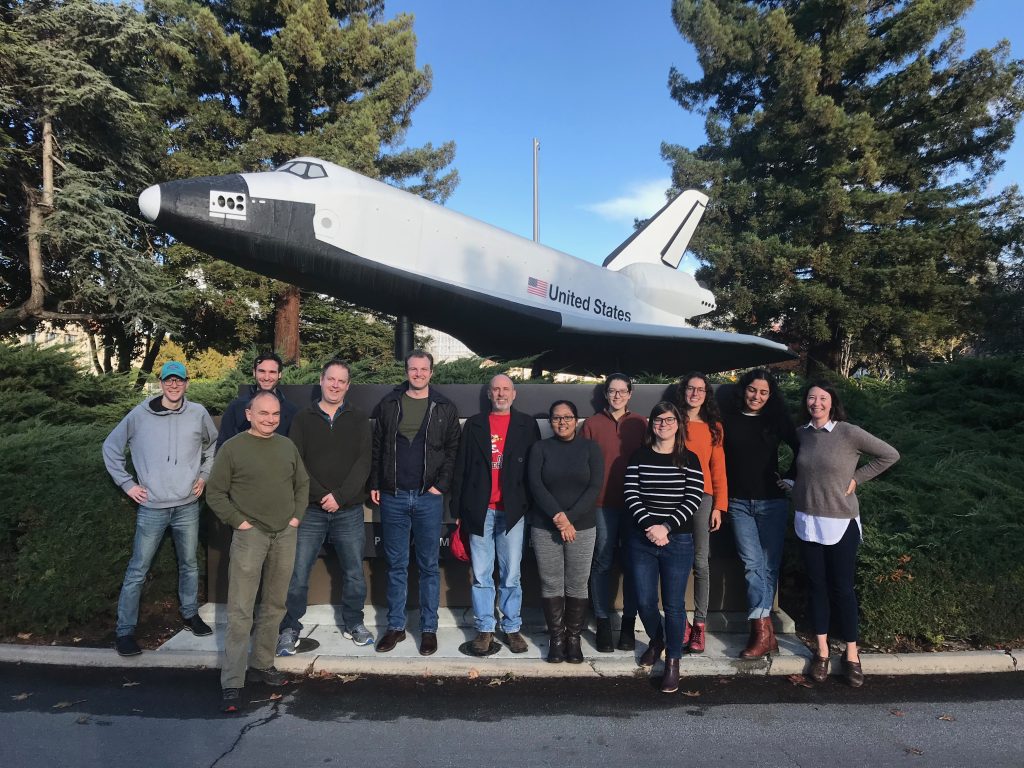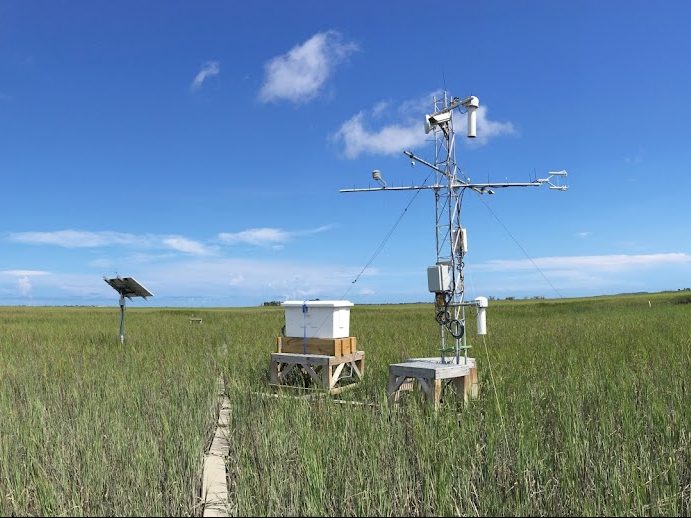Dec 7-8 2019
The Coastal Carbon Research Coordination Network (CCRCN) held its second working group workshop this past December at NASA’s AMES Research Center in Mountain View, CA hosted by the US Geological Survey. This year’s working group is focused on improving predictions of methane emissions from coastal wetlands. Specifically, we aim to compile all methane flux data from tidal wetlands in the continental US to parameterize and validate a set of nested process-based methane models. There were 12 working group members in attendance and all working group member bios are available on the CCRCN website.
Some of the questions the working group is hoping to address include: How well can we predict methane emissions from coastal wetlands across the U.S.? What are the main sources of error? What types of wetlands are the most difficult to model with regard to salinity, disturbance/age, plant community etc.? What data streams are needed to improve our predictions? Can our process-based models predict interannual variability? And what guidance can we give to the science and management communities based on these efforts?
The 2-day workshop was spent examining these questions throughout a series of presentations and break-out discussion sessions. The working group subdivided into 2 groups focused on: 1) data collection and analysis and 2) model development and testing.
Coastal Wetland Methane Flux Data
Sara Knox presented on the state of the data including all identified sites with eddy covariance measurements of ecosystem methane exchange (n=10) as well as sites with chamber measurements (n=20) based on previous syntheses and recent literature search. James Holmquist and Michael Lonnemann presented on leveraging data collection and archiving strategies established by the first CCRCN working group focused on soil carbon burial rates and coastal wetland carbon stocks. This working group plans to use a similar open-access public archive approach which will display all available data in a data clearinghouse on the CCRCN webpage.
During the workshop, the data sub-group elected Ariane Arias Ortiz to spearhead the data collection effort and first analysis of the dataset. The data sub-group aims to identify dominant factors controlling methane emissions in coastal wetlands and understand functional relationships and thresholds between salinity, elevation, temperature, and other biophysical variables. The data sub-group would also like to generate a multivariate empirical model and investigate different time scales of variation in methane fluxes.
Upscaling Methane Fluxes
Issues surrounding temporal and spatial scaling of chamber data was another theme of the workshop. Gavin McNicol gave a talk on upscaling chamber data to the ecosystem scale (McNicol et al., 2017) and led a discussion on approaches for merging chamber and eddy covariance data with the modeling effort. Camilo Rey-Sanchez gave a presentation on footprint analysis, with a focus on how to use chamber flux measurements to attribute ecosystem methane flux measurements to different land cover types (Rey-Sanchez et al., 2018). To hear more about Camilo Rey-Sanchez’s footprint work please see his recent Ameriflux post on using footprint models to resolve methane hotspots. The working group is currently interested in investigating these concepts using the coastal wetland methane dataset to scale chamber measurements to monthly, seasonal, and annual time scales and use sites with both chamber and eddy data to determine how reliable those approaches are across diverse tidal marshes.
Advancing Coastal Wetland Modeling
The modeling sub-group heard from Pat Megonigal on recent developments of the Marsh Equilibrium Model (MEM) (Morris & Bowden, 1986; Morris et al., 2002; Morris et al., 2016) which is being adapted to predict methane emissions at annual time scales. James Holmquist discussed recent work to code up the MEM model in R as well as using the PEcAn platform for data assimilation. I presented on Bayesian hierarchical modeling and the PEPRMT model, a model that was parameterized using a data-model fusion approach with data from a network of eddy covariance towers (Oikawa et al., 2017). Debjani Sihi presented recent modeling work using Dual Arrhenius Michaelis-Menten (DAMM) models that employ probability distribution functions to describe GHG emissions across microsites within the soil (Sihi et al., 2020).
Through multiple break-out discussions the modeling subgroup decided to test a nested set of process-based models that link the MEM, PEPRMT and DAMM microsite models and have a range of complexity. This hierarchy will first be tested at a few select sites with comprehensive datasets not only on methane fluxes but also water table and soil biogeochemical data such as porewater salinity. The modeling group aims to address questions concerning trade-offs between model complexity and accuracy and how they change across different temporal scales. The modeling group also aims to quantify the value of different data sets at different temporal and spatial scales in order to make recommendations to the community for data needs.
Contribute Data to the Working Group
The main goal of the working group is an open-source and public dataset of coastal wetland methane fluxes and an associated data paper with high-level summaries and statistical analyses. If you have chamber-based methane flux data from the contiguous U.S., disaggregated by sampling event, you have the opportunity to contribute at the level of the coauthor. Responsibilities over the next few months will include commenting on a list of potential meta-data and environmental covariates we will collect in addition to the fluxes, making an appointment to consult with our data team about your study, and filling out templates with your meta-data, flux data, and environmental covariates. As the dataset and a draft paper based on it comes together, ordinary coauthor responsibilities will apply, such as commenting on and approving drafts.
If you are interested in participating please contact Ariane Arias-Ortiz [aariasortiz AT berkeley.edu] and Michael Lonneman [LonnemanM AT si.edu].
This post was authored for the AmeriFlux Year of Methane by Patty Oikawa, an Assistant Professor of Earth and Environmental Sciences at California State University East Bay.
References
McNicol, G., Sturtevant, C. S., Knox, S. H., Dronova, I., Baldocchi, D. D., & Silver, W. L. (2017). Effects of seasonality, transport pathway, and spatial structure on greenhouse gas fluxes in a restored wetland. Global Change Biology, 23(7), 2768–2782. https://doi.org/10.1111/gcb.13580
Morris, J. T., Barber, D. C., Callaway, J. C., Chambers, R., Hagen, S. C., Hopkinson, C. S., … Wigand, C. (2016). Contributions of organic and inorganic matter to sediment volume and accretion in tidal wetlands at steady state. Earth’s Future, 4(4), 110–121. https://doi.org/10.1002/2015EF000334
Morris, J. T., & Bowden, W. B. (1986). A mechanistic, numerical model of sedimentation, mineralization, and decomposition for marsh sediments. Soil Science Society of America Journal, 50(1), 96–105. https://doi.org/10.2136/sssaj1986.03615995005000010019x
Morris, J. T., Sundareshwar, P. V., Nietch, C. T., Kjerfve, B., & Cahoon, D. R. (2002). Responses of coastal wetlands to rising sea level. Ecology, 83(10), 2869–2877. https://doi.org/10.1890/0012-9658(2002)083[2869:ROCWTR]2.0.CO;2
Oikawa, P. Y., Jenerette, G. D., Knox, S. H., Sturtevant, C., Verfaillie, J., Dronova, I., et al. (2017). Evaluation of a hierarchy of models reveals importance of substrate limitation for predicting carbon dioxide and methane exchange in restored wetlands. Journal of Geophysical Research: Biogeosciences, 122(1), 145–167. https://dx.doi.org/10.1002/2016JG003438
Rey-Sanchez, A. C., Morin, T. H., Stefanik, K. C., Wrighton, K., & Bohrer, G. (2018). Determining total emissions and environmental drivers of methane flux in a Lake Erie estuarine marsh. Ecological Engineering, 114, 7–15. https://doi.org/10.1016/j.ecoleng.2017.06.042
Sihi, D., Davidson, E. A., Savage, K. E., & Liang, D. (2020). Simultaneous numerical representation of soil microsite production and consumption of carbon dioxide, methane, and nitrous oxide using probability distribution functions. Global Change Biology, 26(1), 200–218. https://doi.org/10.1111/gcb.14855





No Comments
Be the first to start a conversation